2025
WICTO x GCI Seminar 📖
WICTO and GCI will be hosting Dr. Nadine Borduas-Dedekind from the University of British Columbia! An abstract for this talk will be posted on a later date. A roundtable discussion will be held directly after the talk, with lunch provided. Sign up for the roundtable using the link below.
Seminar date: Monday, September 29 at 10:00am – 11:00am EST
Location: Davenport Seminar Room East
Roundtable discussion date: Monday, September 29 at 11:00am – 12:30pm EST
Location: LM319 (3rd floor Enviromental Chemistry Lounge)
Sign-up form: https://forms.gle/htN8mRYBPKLzfmk59
Title: Mutual Allostery: A Mechanism to Regulate RNA Biology
Abstract: In this seminar, I reflect on the twists and turns of my academic career, tracing a path from organic to atmospheric chemistry and through roles in industry, government, consulting, and academia. Along the way, I have asked myself questions that many scientists face, including (1) practical questions like how to decide which group to join, how to manage student-supervisor interactions, how to write manuscripts and proposals, as well as (2) life questions like how to balance research with life choices, how to choose a career path, how to time manage, etc. I will share the “real story” of my career, including the challenges of uncertainty, burnout, and identity in science, as well as the advice and lessons that shaped my decisions. This journey has influences and informed on my mentorship style as a professor and mentor today. My goal with this seminar is to provide an honest perspective on the realities of building a scientific career, the importance of resilience and community, and the opportunities to contribute meaningfully to science and society, while encouraging a discussion on diversity, equity, and the personal dimensions of life in academia. I’m looking forward to an engaging discussion!
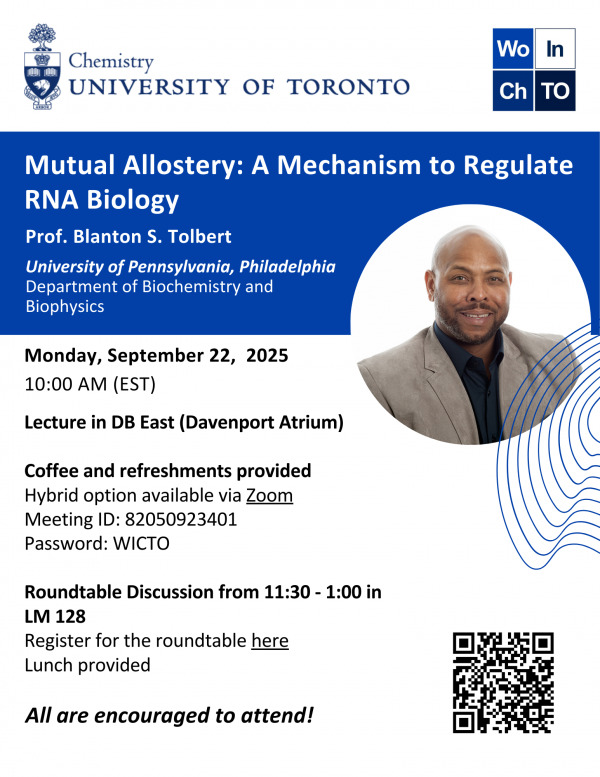 WICTO Seminar 📖
WICTO Seminar 📖
WICTO will be hosting Dr. Blanton S. Tolbert from the University of Pennsylvania! A roundtable discussion will be held directly after the talk, with lunch provided. Sign up for the roundtable using the QR code in the attached PDF or the link below.
Seminar date: Monday, September 22 at 10:00am – 11:00am EST
Location: Davenport Seminar Room East
Roundtable discussion date: Monday, September 20 at 11:30am – 1:00pm EST
Location: LM128
Title: Mutual Allostery: A Mechanism to Regulate RNA Biology
Abstract: Heterotypic RNA–protein (RNP) interactions regulate gene expression, yet the foundational principles governing functional RNP assembly remain largely unknown across most of the transcriptome. This knowledge gap persists in part because heterotypic interactions are highly idiosyncratic, making it difficult to define generalizable rules of engagement. To address this challenge, a new conceptual framework is needed to better understand how heterogeneity contributes to RNA-mediated gene expression. We propose that mutual allostery provides such a framework, both for rationalizing the biological mechanisms underlying gene regulation and for identifying new strategies to therapeutically target RNA.
Allostery describes a phenomenon in which ligand binding at one site induces conformational changes at a distant interaction surface. In heterotypic RNPs, mutual allostery can impose more precise and stringent control over RNA biology, as the respective complexes display unique physicochemical properties. In my presentation, I will discuss case studies that provide evidence supporting mutual allostery as a potentially generalizable framework for interpreting the contributions of heterotypic interactions to RNA biology.
2024
 Anne McNeil (she/her) (Department of Chemistry; Macromolecular Science and Engineering, University of Michigan)
Date: April 11, 2024
Anne McNeil (she/her) (Department of Chemistry; Macromolecular Science and Engineering, University of Michigan)
Date: April 11, 2024
Time: Seminar @ 11 AM, Roundtable @ 12:00 AM
Seminar Location: Davenport East
Title: Sustainable Materials & Diversifying Chemistry
Abstract:
Plastics have completely transformed our lives, while at the same time having a significant negative impact on our environment. Our research is aimed at developing synthetic approaches to more sustainable polymers. This talk will highlight two projects ongoing within our group. In both projects we aim to use synthetic chemistry to give a current high-production-volume plastic a second life, attenuating its impact on the environment. In addition, I will discuss Diversify Chemistry and other initiatives aimed at helping the field be more inclusive.
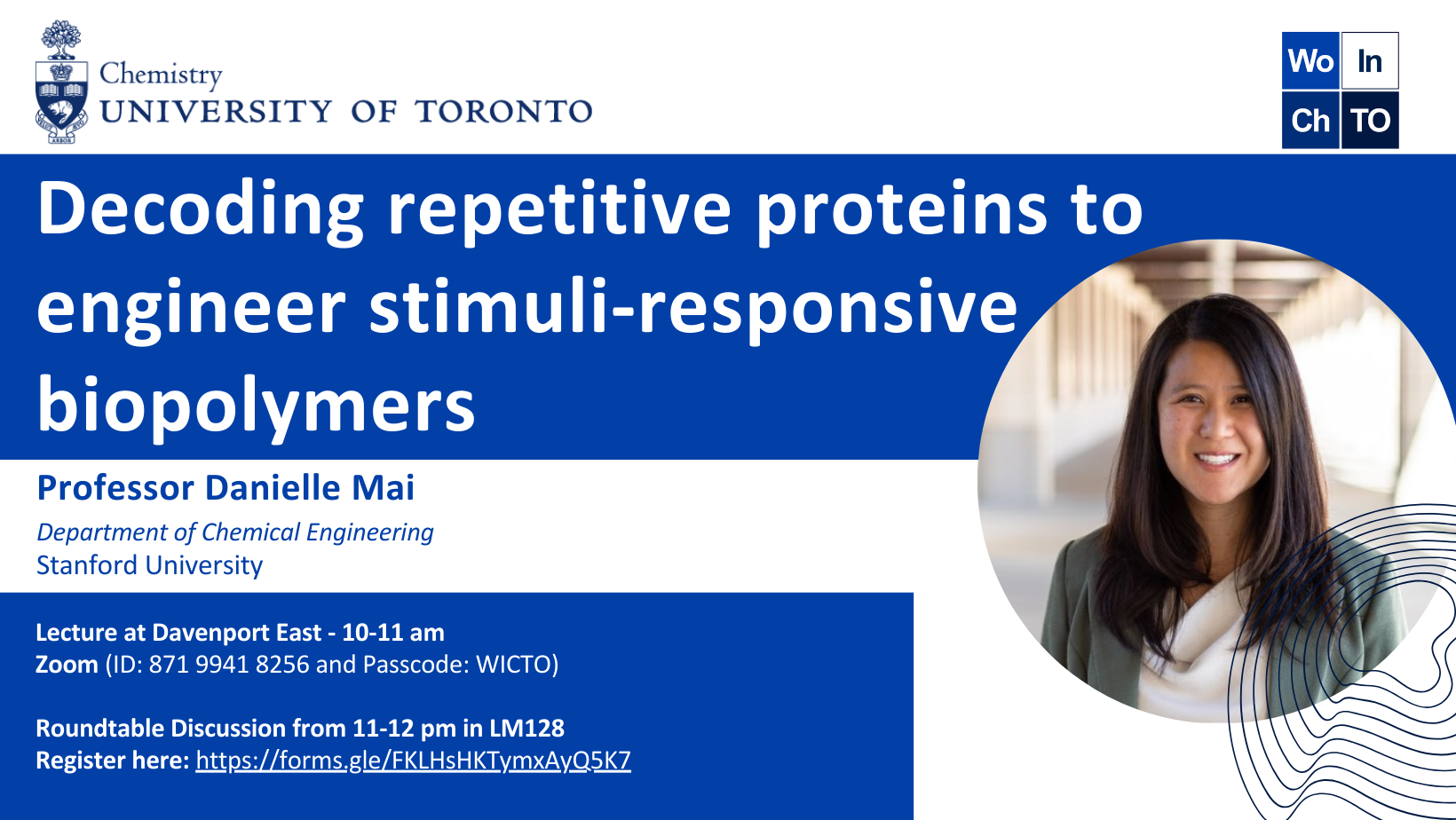 Danielle Mai (she/her) (Department of Chemical Engineering, Stanford University)
Date: February, 16, 2024
Danielle Mai (she/her) (Department of Chemical Engineering, Stanford University)
Date: February, 16, 2024
Time: Seminar @ 10 AM, Roundtable @ 11:00 AM
Seminar Location: Davenport East
Title: Decoding repetitive proteins to engineer stimuli-responsive biopolymers
Abstract:
Evolution allows organisms to adapt to their environments, yet some molecular patterns stay constant through billions of years of evolution. These patterns encode the secrets of biological materials, such that similar patterns often emerge in different materials with similar functions. A family of elastin proteins form stretchable fibers, which allow the constant movement of human skin, blood vessels, and lungs. To decode these secrets, the Mai group looks for patterns in the sequences of proteins with similar functions. These conserved sequences often emerge from repetitive regions, and “consensus repeat sequences” provide a convenient platform to investigate protein sequence–biomaterial property relationships.

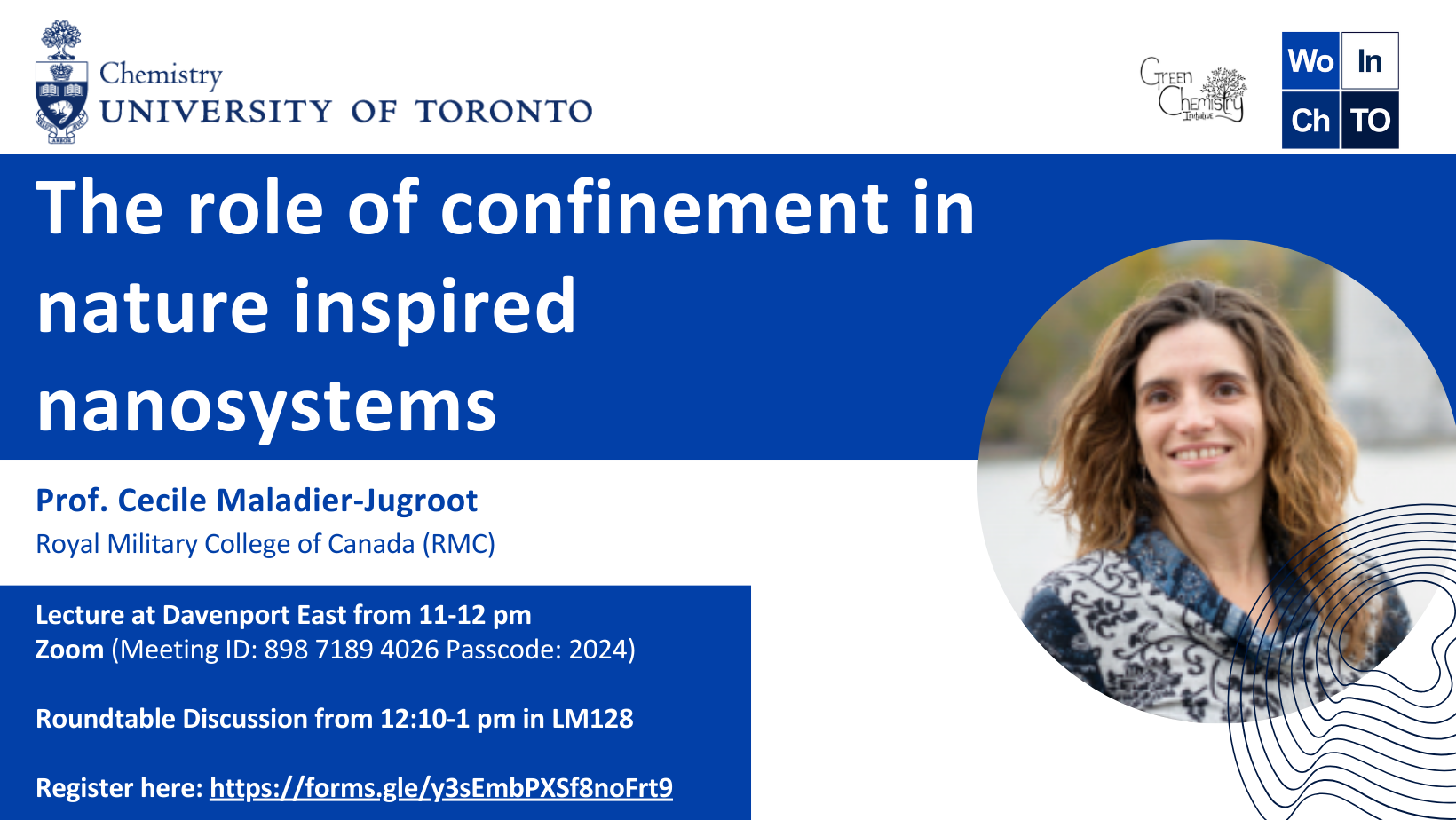
Cecile Maladier-Jugroot (she/her) (Royal Military College of Canada (RMC))
Date: January 17, 2024
Time: Lecture @ 11 PM, Roundtable @ 12:00 PM
Seminar Location: Davenport East
Title: The role of confinement in nature inspired nanosystems
Abstract:
The development of nature-inspired processes has shown great promises in several fields: in the synthesis of highly active nanocatalysts; for the development of green processes for the use of sustainable energy sources; or in targeted drug delivery systems. In particular, biomimetism can be divided in two main research areas: (A) utilizing elements of biological systems or (B) mimicking its function and physical properties. The first approach (A) often combines biological components to artificial systems to take advantage of the high efficiency of the biological processes. However, due to the high sensitivity of the biological components to change in their environment, the efficiency of these structures can decrease significantly with small perturbations. The second method (B) developed to mimic the physical properties and enhanced reactivity of biosystems has the distinct advantage of allowing the development of tailored structures stable under various conditions retaining the very high efficiency of their biological counterparts and is the focus of this presentation.
The presentation will detail the combination of molecular modelling and experimental characterization methods from the design to the development of nanosystems for specific applications. The first theme will focus on the tailoring of nanoreactors in aqueous solution with an emphasis on the dimensionality of the confinement and its effect on the kinetics and thermodynamics of reaction under confinement [1-3]. In addition, the controlled synthesis of stable and highly efficient 2D Au catalysts within the confined environment will be presented. The second application will provide a detailed design of targeted drug delivery systems for cancer combining three targeting strategies [4-6] from the tailoring of the system using molecular modeling to synthesis, characterization and testing on single cells and tumor spheroids.

2023
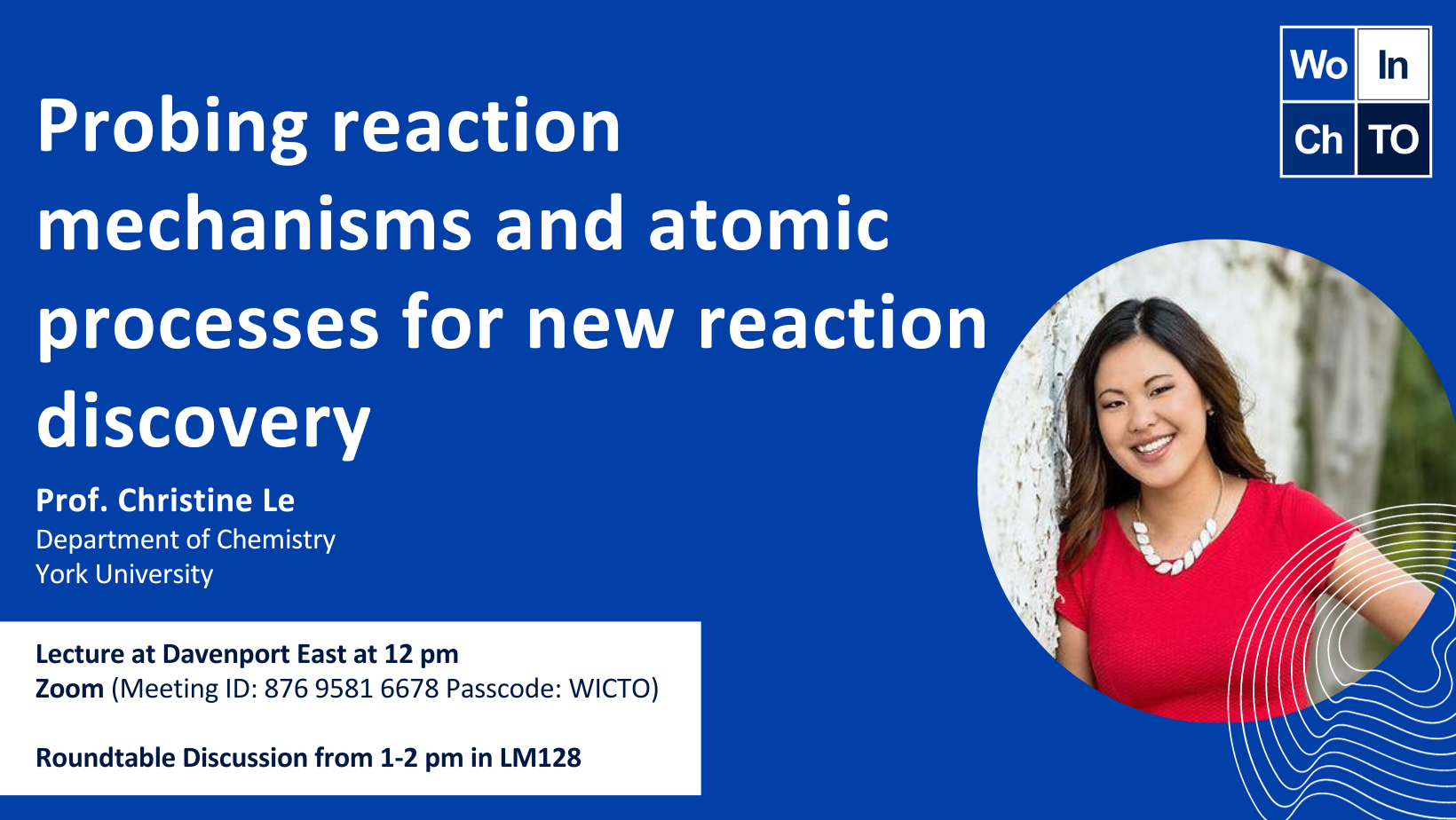
Christine Le (she/her) (Department of Chemistry, York University)
Date: Tuesday, October 24, 2023
Time: Lecture @ 12 PM, Roundtable @ 1:00 PM
Seminar Location: Davenport East
Title: Probing reaction mechanisms and atomic processes for new reaction discovery
Abstract:
Prof. Le’s lab develops new reactions that expand the ‘toolbox’ that organic chemists can use to synthesize molecules in the laboratory to increase the efficiency of various industrial processes, by providing alternative and complementary methods to stitch chemical bonds. Particularly, her lab aims to develop robust methods to access unique heterocycles, carbocycles, and fluorine containing molecules that expand the chemical space for drug discovery. Using a mechanism driven approach to reaction discovery, they strive to create more sustainable chemical syntheses that capitalize on the use of renewable resources, while reducing or eliminating the production of hazardous substances.
2022
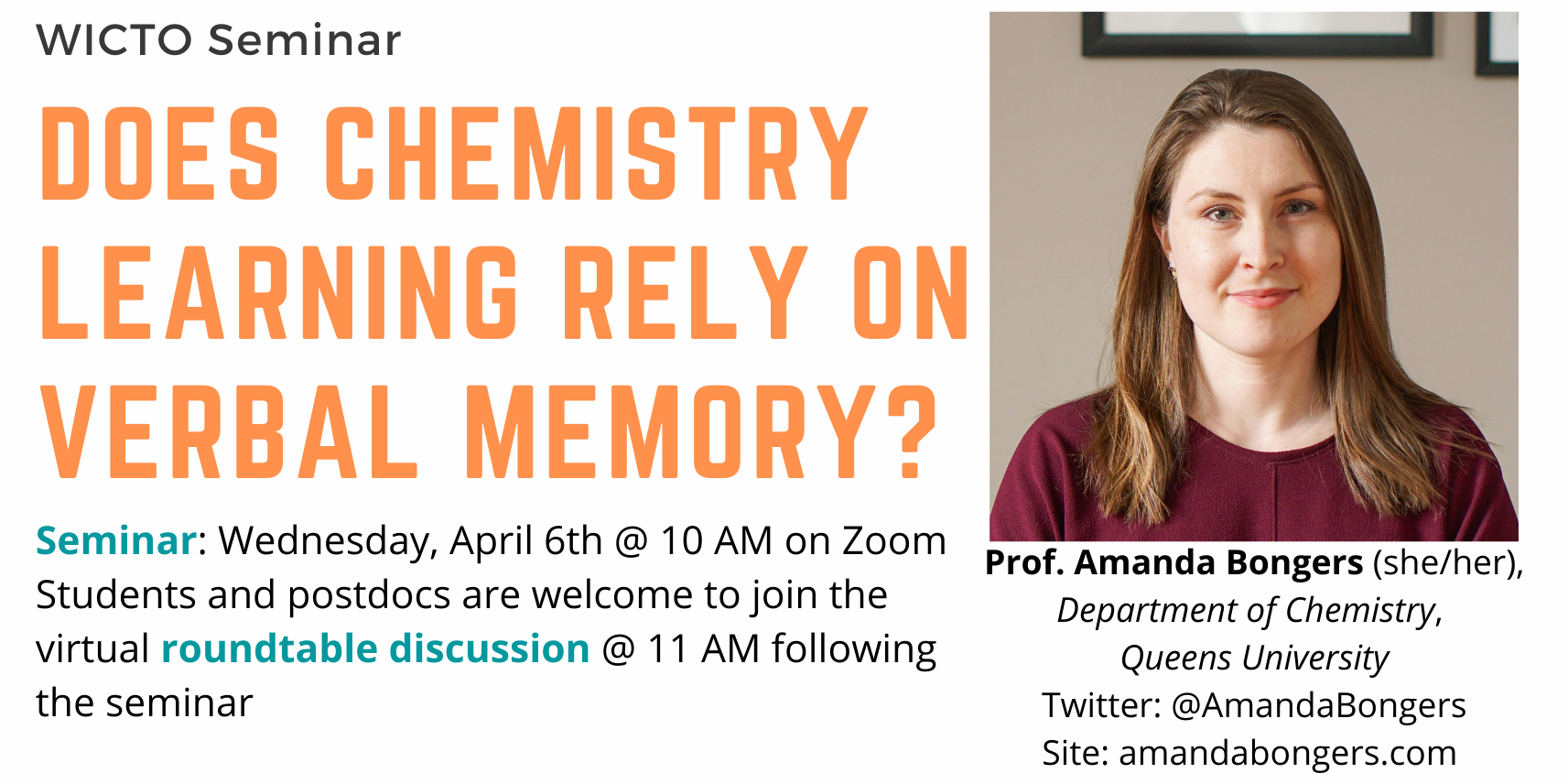
Amanda Bongers (she/her) (Department of Chemistry, Queens University)
Date: Wednesday, April 6, 2022
Time: Seminar @ 10 AM, Roundtable @ 11:00 AM
Seminar Location: Zoom
Title: Does Chemistry Learning Rely on Verbal Memory?
Abstract:
If you are shown the molecule CH3OH, how does your brain represent it in your mind? Is it "See-Aych-Three-Oh-Aych" or "methanol", or do you visualize a 3-dimensional molecule, a clear liquid, or a characteristic odour? Despite decades of research into working memory, we still know little about how people encode and visualize scientific models in their minds. Our research group is trying to answer the questions: How do people encode and visualize chemistry models, which strategies help students, and what does this mean for learning? In our lab, we are modifying classic memory experiments and using them to study chemistry cognition. This research targets fundamental questions that can shed light on learning chemistry in modern classrooms or digital environments.
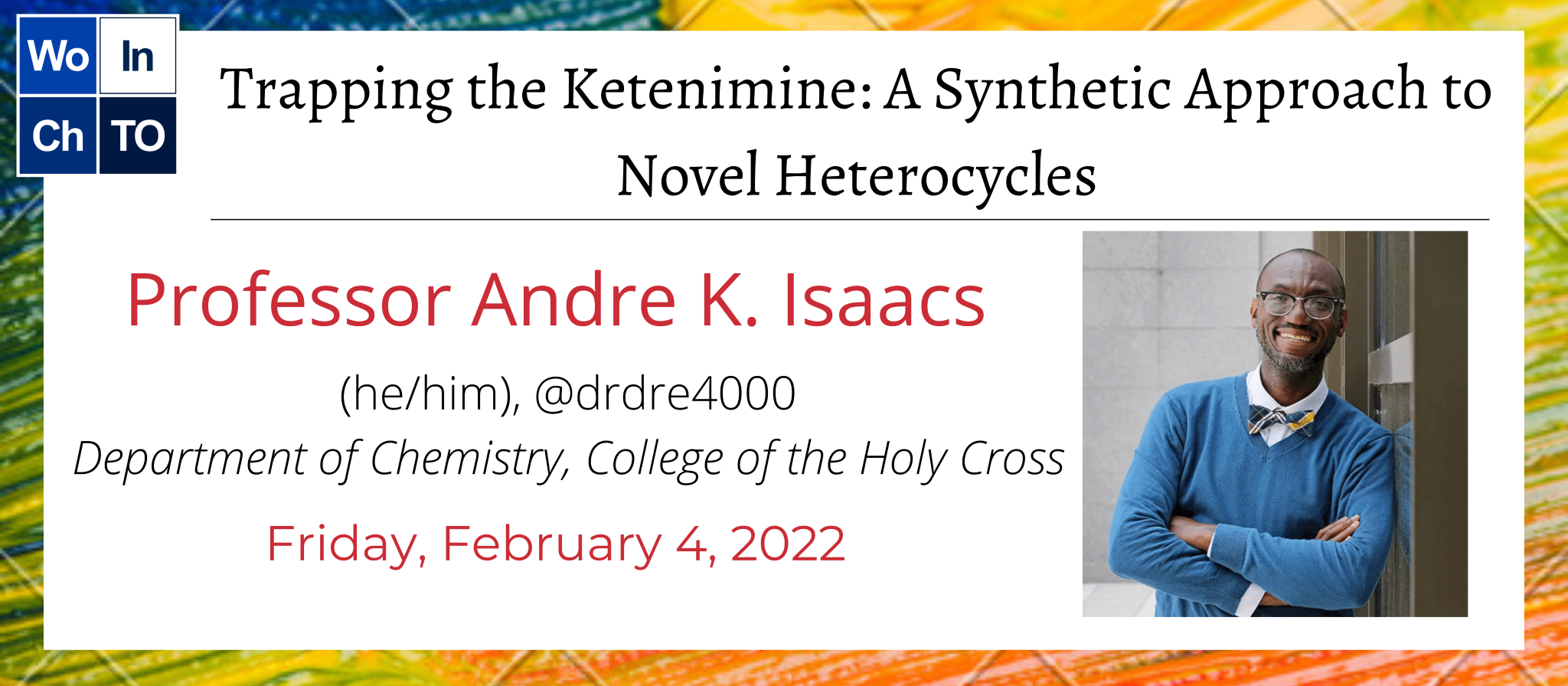
Andre K. Isaacs (Professor, Department of Chemistry, College of the Holy Cross)
Date: Friday, February 4, 2022
Time: Seminar @ 10 AM, Roundtable @ 11:00 AM
Seminar Location: Zoom
Title: Trapping the Ketenimine: A Synthetic Approach to Novel Heterocycles
Abstract:
Our research interests are centered on a very reliable organic reaction - the copper-catalyzed cycloaddition of sulfonyl azides and terminal alkynes (CuAAC). Differential fragmentation of the resulting 1,2,3-triazole generates ketenimines and rhodium carbenoids which readily engage with a variety of nucleophiles to gain access to heterocycles of interest to the synthetic community. Herein, we demonstrate the utility of ketenimines in the synthesis of N-Heterocycles such as indolizines, dihydroisoquinolines and beta-lactams.
Check out Professor Isaacs on social media @drdre4000!
2021
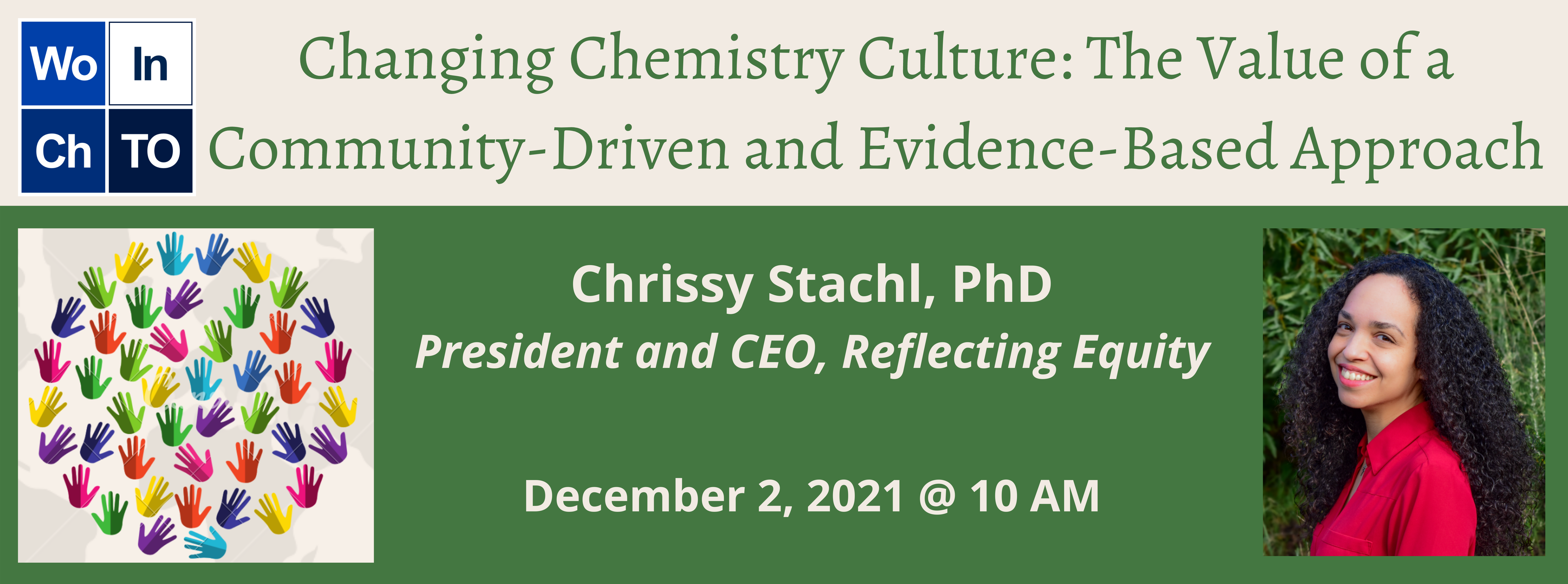
Chrissy Stachl (President and CEO, Reflection Equity)
Date: Thursday, December 2nd, 2021
Time: Seminar @ 10 AM, Roundtable @ 11 AM
Location: Zoom
Title: Changing Chemistry Culture- The Value of a Community-Driven and Evidence-Based Approach
Abstract:
Lack of representation and stem remains a significant issue at every academic level. While many initiatives to improve diversity exist, they primarily focus on recruiting more women and individuals from historically marginalized groups and fail to address the systemic issues that prevent these individuals from thriving. Given that every academic community has a unique historical narrative, it is critical to identify the specific issues that negatively affect the given communities climate and culture before devising strategies to increase diversity.
This talk will focus on the results of the quantitative, multi-year effort to improve the academic climate of a chemistry graduate community. In particular, we will discuss the methods used to assess the challenges facing graduate students, postdocs, and faculty and how the community's own data were used to ground cooperative efforts to drive positive change. This talk will also focus on the use of a practical, sustainable, and data-driven framework for affecting institutional change within a graduate community and how that framework grounds Dr. Stachl's current work as a consultant to promote positive cultural change in other communities.
Learn more about Dr. Stachl's work by visting her website.
resize.png)
David K. Smith (Department of Chemistry, University of York)
Date: Wednesday, October 20, 2021
Time: Seminar @ 9 AM, Roundtable @ 10:10 AM
Seminar Location: Zoom
Title: Harnessing the Power of Diversity- Chemistry Gets Personal
Abstract:
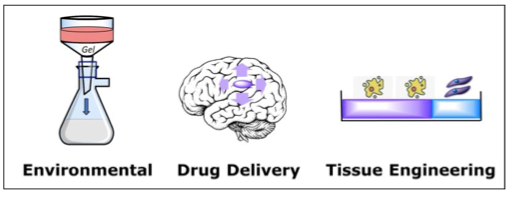
Diverse scientists will have diverse ideas and approaches- essential for cutting-edge research. Furthermore, happy, fulfilled scientists will perform better and achieve more. Indeed, if we only care about the science, and not the people who do it, we simply won’t generate the best results .1 This lecture will reflect on my own personal experience and, in particular, explore the representation of LGBT+ scientists .2 We will focus on why it matters that science should not only be diverse, but seen to be diverse- of particular importance for LGBT+ scientists, where their diversity can sometimes remain hidden or suppressed. We will also consider how the culture of science needs to change to embrace diversity, and the steps we can take to achieve this.
Inspired by the power of combining the diversity of individual scientists, we will also explore some research from my lab, which combines many diverse individual molecular components. We create gel-phase materials using self-assembly of molecular building blocks - a “bottom-up” approach to nanofabrication.3 Each individual molecular component brings its own “personality” to the resulting gel, which is endowed with high-levels of functionality as a result.4 The use of self-assembly methodology means these materials can be very easily formed from low-cost environmentally-friendly molecular-scale building blocks. This opens the possibility of high-tech applications being achieved by what are, in essence, very simple supramolecular materials.5 We will exemplify our development of supramolecular gels focusing on gelators that are synthesized from sorbitol using commercially-relevant methods,6 and form responsive, smart hydrogels. In particular, our programme of research has introduced innovative methods, using diverse components, to shape, pattern, and structure these gels.7 We will explore the potential applications of these gels in a variety of settings, including environmental remediation,8 and, inspired by my own personal experience, drug delivery,9 and regenerative medicine.10
References
- D.K. Smith, Nat. Chem. 2020, 12, 101.
- D.K. Smith, Matter, 2019, 1, 1439.
- R. G. Weiss, J. Am. Chem. Soc., 2014, 136, 7519-7530
- J. Raeburn, D.J. Adams, Chem. Commun., 2015, 51, 5170-5180
- D.K. Smith, in Molecular Gels: Structure and Dynamics, Ed. R. G. Weiss, RSC, Cambridge, 2018, pp 300-371
- B. O. Okesola, V. M. P. Vieira, D. J. Cornwell, N. K. Whitelaw, D. K. Smith, Soft Matter, 2015, 11, 4768-4787.
- P. R. A.Chivers, D. K. Smith, Nat. Rev. Mater. 2019, 4, 463-478.
- B. O. Okesola, D. K. Smith, Chem. Soc. Rev., 2016, 45, 4226-4251. P. Slavik, D. W. Kurka, D. K. Smith, Chem. Sci. 2019, 58, 4173. C.C. Piras, P. Slavik, D. K. Smith, Angew. Chem. Int. Ed. 2020, 59, 853.
- P. R. A. Chivers, D. K. Smith, Chem. Sci., 2017, 8, 7218. C.C. Piras, C. S. Mahon, D. K. Smith, Chem. Eur. J., 2020, 26, 8452. C.C. Piras, A.K. Patterson, D.K. Smith, Chem. Eur. J. 2021, 27, 13203. J.T.-W. Wang, A.C. Rodrigo, A.K. Patterson, K. Hawkins, M.M.S. Aly, J. Sun, K.T. Al-Jamal, D.K. Smith, Adv. Sci. 2021, 2101058.
- V. M. P. Vieira, A. C. Lima, M. de Jong and D. K. Smith, Chem. Eur. J. 2018, 24, 15112. C. C. Piras, A. G. Kay, P. G. Genever, D. K. Smith, Chem. Sci. 2021, 12, 3958.
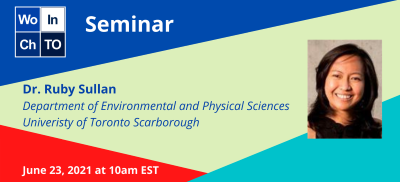
Ruby Sullan (Department of Physical and Environmental Sciences, University of Toronto Scarborough)
Date: Wednesday, June 23, 2021
Time: Seminar @ 10 AM, Roundtable @ 11:15 AM
Location: Zoom
Title: Evidence-Centered Design to Engage in Green Chemistry Decision-Making about Sustainability Problems
Abstract: The call for green (and sustainable) chemistry to be a prominent feature in the training of future chemists has been growing for the last twenty years. Long-standing, thoughtful efforts to infuse green and sustainable chemistry into the undergraduate curriculum have propagated slowly from their designers. These efforts are complicated by the desire to incorporate Systems Thinking and complex phenomena into introductory courses. Without an underlying knowledge of chemistry, students are unlikely to use Systems Thinking in a meaningful sense. The difficulty may well lie in inadvertently treating green and sustainable chemistry as a set of topics or enumerations of the twelve principles of green chemistry in the context of complex systems or grand global challenges. Without an evidence-centered design to support core idea connections, curricular materials tend to not align with theories about the development of expertise, which further compounds the fragmentary nature of student understanding of the discipline of chemistry. A more tractable view is of green chemistry is a set of decisions that one can make—based on a rich knowledge-base of chemistry core ideas—rather than a set of concepts themselves. Successful integration of green chemistry into the curriculum requires a deep knowledge of how people learn and an understanding of how to use this knowledge to design curricula and curricular materials to support learning. That is, there is an urgent need for (1) a theory of learning that can support students’ green and sustainable thinking, (2) curricular activities that are supported by theory and is informed by the results of assessment, and (3) assessments to measure students’ knowledge-in-use.
2020
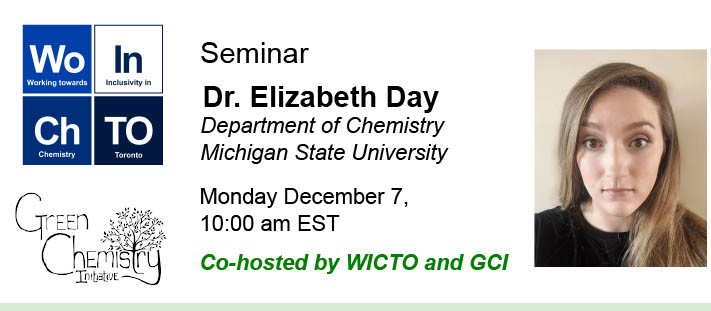
Dr. Elizabeth Day (Department of Chemistry, Michigan State University)
Date: Monday, December 7, 2020
Time: Seminar @ 10 AM, Roundtable @ 11:15 AM
Location: Zoom
Title: Evidence-Centered Design to Engage in Green Chemistry Decision-Making about Sustainability Problems
Abstract: The call for green (and sustainable) chemistry to be a prominent feature in the training of future chemists has been growing for the last twenty years. Long-standing, thoughtful efforts to infuse green and sustainable chemistry into the undergraduate curriculum have propagated slowly from their designers. These efforts are complicated by the desire to incorporate Systems Thinking and complex phenomena into introductory courses. Without an underlying knowledge of chemistry, students are unlikely to use Systems Thinking in a meaningful sense. The difficulty may well lie in inadvertently treating green and sustainable chemistry as a set of topics or enumerations of the twelve principles of green chemistry in the context of complex systems or grand global challenges. Without an evidence-centered design to support core idea connections, curricular materials tend to not align with theories about the development of expertise, which further compounds the fragmentary nature of student understanding of the discipline of chemistry. A more tractable view is of green chemistry is a set of decisions that one can make—based on a rich knowledge-base of chemistry core ideas—rather than a set of concepts themselves. Successful integration of green chemistry into the curriculum requires a deep knowledge of how people learn and an understanding of how to use this knowledge to design curricula and curricular materials to support learning. That is, there is an urgent need for (1) a theory of learning that can support students’ green and sustainable thinking, (2) curricular activities that are supported by theory and is informed by the results of assessment, and (3) assessments to measure students’ knowledge-in-use.

Ismael Y. Mourifié (Department of Economics, University of Toronto)
Date: Monday, November 2, 2020
Location: Zoom
Title: Why are Women Underrepresented in STEM Fields? An Economic Perspective.
Abstract: In many developed countries, women are underrepresented in the fields of STEM. While some progress has occurred in Canada, it has been at a very slow pace. In 1987, 20% of people working in STEM were female, compared to 22% today. The underrepresentation of women in STEM jobs is often cited as a major contributor to the gender wage gap. This talk aims to understand the main reasons for the underrepresentation of Women in STEM in order to determine adequate policies that would mitigate female underrepresentation in STEM fields and potentially reduce the gender wage gap.

Dr. Raychelle Burks (St. Edward's University, Texas)
Date: Monday, February 24th, 2020
Location: Davenport East, Lash Miller Chemical Laboratories
Title: Seeing clearly: exploring new vapor-phase stains for cyanoacrylate processing of latent prints
Abstract: Visualizing cyanoacrylate super-glue fumed latent prints can present a challenge to forensic scientists as a variety of print surfaces may require a post fuming secondary step with a stain solution to render prints observable. In this talk, Dr. Burks will discuss her group's development and evaluation of a single-step vapor-phase staining process using select benzoic acid derivatives.
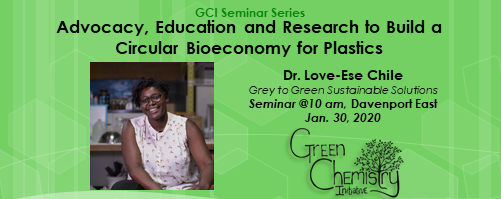
Dr. Love-Ese Chile (Grey to Green Sustainable Solutions)
Date: Thursday, January 30, 2020
Location: Davenport East, Lash Miller Chemical Labs
Title: Advocacy, Education and Research to Build a Circular Bioeconomy for Plastics
Abstract: Sustainable science is concerned with creating technologies that will help our communities grow and thrive; science that can inform and empower us to take a “bottom-up” view of climate change and build sustainable innovative cities. In this presentation, Dr. Love-Ese Chile will speak about her pathway to becoming one of a growing group of Sustainable Scientists advocating for the use of green technologies in community settings. An important aspect of sustainable science is to explore the social and cultural practices at the core of sustainability issues; how did we arrive here and, what will drive us to where we want to be? Dr. Chile will speak about her work to drive adoption of the circular bioeconomy for plastics. The circular bioeconomy is a material eco-system, in which products are designed to be made from renewable feedstocks, with an end-of life scenario that returns value in the form of organic nutrients for the soil or technical use. Environmental contamination from plastic waste is forefront in the public and political dialogue, both in Canada and abroad. Advocating for bio-derived and biodegradable plastics that mitigate these problems and defining appropriate policies to guide their use is now an important point of focus. The circular economy for bio-derived and biodegradable plastic requires participation all stakeholder groups, not only researchers and product producers, but also policy makers, retail business, consumers, recovery operators and reprocessors. All of whom need to have a strong understanding of the role these materials will play in order to reduce waste, stem leakage into the environmental and recirculate biological value.
2019
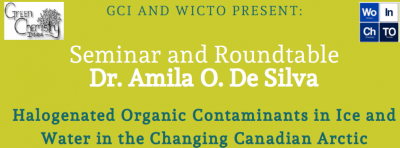
Dr. Amila O. De Silva (Environment and Climate Change Canada)
Date: Thursday, December 5, 2019
Location: Davenport East, Lash Miller Chemical Laboratories
Title: Halogenated organic contaminants in ice and water in the changing Canadian arctic
Abstract: How do contaminants arrive in the Arctic, what happens to them, and how will climate change impact these processes? Even in pristine Arctic regions such as ice caps, contaminants are present. In 2015, we conducted a field sampling campaign to extrude an ice core from the Devon Island ice cap. Through sectioning and dating the core, we have identified contaminant temporal trends over the last 50 years, providing insight into long range atmospheric transport mechanisms of contaminants and contemporary emission trends. We also know that marine transport is a source of contaminants to the Arctic. In aquatic ecosystems in the Arctic, many emerging and legacy organic contaminants undergo bioaccumulation from water to lower food web organisms with subsequent magnification in higher trophic organisms such as seals and polar bears. This is of concern to Indigenous communities due to the immense value cultural value and nutrition in traditionally harvested foods. Recently, we launched a community-based seawater monitoring program under the Northern Contaminants Program to better understand the impact of seasonal variability such as the effects of ice cover and melting periods on contaminants in the underlying water. Arctic ecosystems are experiencing rapid changes due to climate change. At the Cape Bounty Arctic Watershed Observatory, two adjacent and geographically similar lakes are currently undergoing climate-driven changes. One lake has experienced numerous large active layer detachments, sustaining turbid conditions due to sub-aqueous slumping. We have investigated contaminants in these two lakes to provide insight into climate-driven contaminant transport in Arctic lacustrine systems.
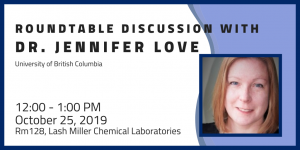
Dr. Jennifer Love (University of British Columbia)
Date: Friday, October 25, 2019
Location: Lash Miller Chemical Laboratories, Rm 158
Title: Exploring mechanisms of nickel-catalysed reaction
Abstract: There has been a considerable effort to move away from the use of precious metals in catalysis, and instead use first row transition metals. However, the mechanistic understanding of how first row metals react is quite limited compared to second and third row metals. The knowledge of how second and third row metals react cannot be simply extended to first row metals, as first row metals have weaker bonds to ligands, can be high spin, and have more oxidation states available. We have been exploring the mechanisms of various nickel-catalysed reactions. Our efforts in these areas will be described.
Nicole Goodwin
Date: Thursday, February 14th, 2019
Location: Lash Miller Chemical Laboratories, Davenport East Seminar Room
Abstract: Rational drug design, simply stated, is the process of identifying a new drug that elicits a desired pharmacology against a biological target. While the word “rational” can elicit a lengthy discussion in itself, the context as described here will be from the perspective of a synthetic medicinal chemist where a particular challenge and goal were presented and rational design was used to progress a small molecule to the finish line. These two case studies will showcase very different approaches to rational design and highlight the strategic thinking within each.
The first will illustrate the power of structure-based drug design integrated with a fragment-based discovery strategy to ultimately identify small molecule KI-696 as an extremely potent activator of the Nrf2 pathway.
The second example will illustrate a knowledge-based approach to xylose-based selective SGLT1 inhibitors designed to be restricted to the gastrointestinal tract. A chemical instability that would have hampered development of these compounds was observed and the origin and solution to this instability will be discussed.
2018
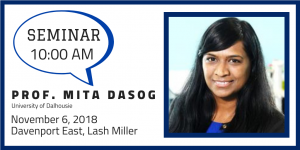
Prof. Mita Dasog
Date: Tuesday, November 6, 2018
Location: Lash Miller Chemical Laboratories, Davenport East Seminar Room
Abstract: Hydrogen produced by splitting water is an attractive clean fuel source and a chemical feedstock. Inexpensive and stable catalysts are required to generate hydrogen from water on a large scale at low cost. Furthermore, the catalyst synthesis should be feasible and scalable to make it commercially viable. This presentation will highlight solid-state synthetic methods developed in our lab to prepare inexpensive, nanostructured, photo- and electro-catalysts for water-splitting reactions. The influence of synthesis conditions on the physical properties of the nanostructures and their catalytic performance will also be discussed.

Prof. Trisha Andrew
Date: Friday, March 16, 2018
Location: Lash Miller Chemical Laboratories, LM158
Abstract: Commonly-available, mass-produced fabrics, yarns and threads can be transformed into a plethora of wearable, skin-mountable and/or biocompatible electronic devices upon being coated with films of intrinsically conducting polymers, such as poly(3,4-ethylenedioxythiophene). Tremendous variation in the surface morphology of conjugated polymer-coated fibres can be observed with different coating or processing conditions. In turn, the morphology of the conjugated polymer active layer determines electrical performance and, most importantly, device ruggedness. I will discuss our lab’s efforts in using reactive vapour deposition methods to create electronically-active textiles. Vapour coating methods allow for a conjugated polymer to be directly formed on any textile or fibre substrate in the vapour phase, without the need for detergents, fixing agents or surface pretreatments, which can reduce the overall number of steps involved in current textile manufacturing routines and curtail the significant solvent use associated with textile production. Further, vapour coating yields uniform and conformal films on fibre/fabric surfaces and produces conductive materials without any insulating moieties. Selected technologies will be described, including touch-sensitive textiles for interactive electronics; smart elbow braces for movement sensing; textile triboelectric generators that convert small body motions into stored energy; wear-, wash- and ironing-resistant conductive cloths that generate heat with a small applied voltage; and thread/yarn supercapacitors that can be sewed or knitted into garments for wearable and portable energy storage.
2017
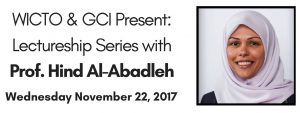
Prof. Hind Al-Abadleh
Date: Wednesday, November 22, 2017
Location: Lash Miller Chemical Laboratories, Davenport Seminar Rooms (3rd floor)
Abstract: Most environmental processes occur at the interface between the different phases of matter present in natural and industrial systems. In each of these processes, surfaces, mainly oxides and hydroxides of transition metals, are present under very different ambient conditions. This talk will present an overview of research activities in Al-Abadleh’s lab at Laurier in the area of environmental surface chemistry. Specifically, projects on the fate of arsenic compounds in simulated geochemical environments in the absence and presence of organic matter will be presented. Also, recent results will be shown on the atmospheric chemistry of iron in secondary organic particle formation from aliphatic and aromatic precursors. The significance of this research will be highlighted in relation to the cycling of arsenic in water and soil, and potentially new pathways for metal-driven atmospheric brown carbon formation and aging of mineral dust aerosols.
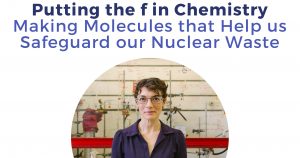
Prof. Polly Arnold
Date: Monday, March 13, 2017
Location: Bahen Centre, Adel S. Sedra Seminar Room (BA1160)
Abstract: A fundamental understanding is needed to develop safe, long-term handling of our nuclear waste legacies and for cleaner ways to extract technology-critical rare earth metals. The subtleties of structure and bonding in compounds of uranium, the heaviest naturally occurring element, and its neighbours in the f-block are still poorly-understood. Drawing on our research to make exotic new molecules from these metals, this lecture will explore what chemistry can teach us about these complicated but important metals.

Dr. Renee Hlozek
Date: Monday, March 13, 2017
Location: Lash Miller Chemical Laboratories, Davenport Seminar Rooms (3rd floor)
Abstract: After a brief introduction to cosmology and how looking into the cosmic past can teach us about our future, I’ll discuss the diversity of the STEM disciplines. I’ll highlight how we can shape and frame our understanding of who participates in STEM discourse in a rigorous way, with some concrete advice for improving the diversity on the axes of race, ethinicity, gender, sexual orientation, physical and neurological ability.

Dr. Malika Jeffries-EL
Date: Friday, February 3, 2017
Location: Lash Miller Chemical Laboratories, LM158
Abstract: Since their discovery over 40 years ago conjugated polymers have been of tremendous scientific and technological interest. These materials posses many exceptional electronic, optical and thermal properties and thus are well suited for organic semiconducting applications, such as solar cells and light emitting diodes. Unfortunately, there are several issues that have to be addressed before real-life products can be developed. Our group focuses on the design and synthesis of new types of conjugated polymers based from low cost and/or easily prepared starting materials. Since the properties of organic semiconductors can be readily modified through chemical synthesis, we have turned our attention towards the design and synthesis of novel building blocks. Our system of choice, polybenzobisazoles possess many exceptional electronic, optical and thermal properties and thus are ideally suited for diverse organic semiconducting applications. However, these materials have found limited utility due their lack of solubility in organic solvents and the harsh conditions required for their synthesis. The resolve this issue, our group has developed a mild approach for the synthesis of benzobisoxazoles resulting in several building blocks suitable for designing new polymers. As a result we have been able to prepare wide band gap materials for use in organic light-emitting diodes and narrow band gap materials for use in photovoltaic cells. We have also pioneered the synthesis of benzodifuran, the oxygen analog of the popular electron rich building block benzodithiophene and are developing narrow band gap conjugated polymers based on it. Our work on the synthesis and properties and utility of these polymers will be presented.
2016

Dr. Miriam Diamond
Date: Thursday, December 15, 2016
Location: Lash Miller Chemical Laboratories, Davenport East Seminar Room (3rd floor)
Abstract: Most women experience no or minimal gender bias as they move through undergraduate and graduate school. At University of Toronto, most faculty candidates and early career faculty will have an experience free of gender bias. Have we been successful in creating an atmosphere free of gender bias at the University? Is an atmosphere free of gender-bias widespread at other universities? What do the statistics and the literature tell us about overt and subtle gender bias at universities and beyond? University of Toronto has been a leader amongst institutions in minimizing gender bias. Current statistics show 7 out of 18 divisions employ more than 40% female faculty and 9 of the remaining divisions have increased the numbers of women hired over the past 10 years. However, although women are more likely than men to be chosen for an interview, women are less likely to receive an offer. These statistics fit the “scissor” effect of attrition of women through the ranks. Recent research shows subtle gender bias by both men and women in terms of hiring and evaluation. Finally, we will explore what the future might hold. Although we have made great strides to reduce gender bias in many universities and in many parts of Canadian society, will women be able to continue to exercise self-determination in the future?
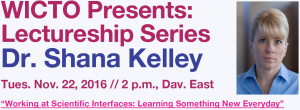
Dr. Shana Kelley
Date: Tuesday, November 22, 2016
Location: Lash Miller Chemical Laboratories, Davenport East Seminar Room (3rd floor)
Abstract: Our research group uses a foundation in Chemistry to develop devices and molecules that allow biology to be studied in new ways. We exploit the interfaces of Chemistry with Materials Science, Engineering and Biology to maximize the impact of our effort, and we constantly fold new approaches into our research projects to take them in exciting directions. We use the unique properties of nanomaterials to develop ultrasensitive approaches to the detection of biomolecular analytes and rare cells, eventually turning these sensors into devices that can be used in the clinic. We also develop molecular delivery systems that can specifically bring molecular cargo to a particular part of the cells. I’ll provide an overview of these research areas, and also discuss the experience of running a research group as a female scientist.

Tracy Primeau
Date: Thursday, October 20, 2016
Location: Lash Miller Chemical Laboratories, Davenport East Seminar Room (3rd floor)
Abstract: Tracy, winner of the 2015 Women of Distinction Award, is an Authorized Nuclear Operator at Bruce Power, where she is responsible for the overall safe operation of her assigned unit at the Bruce ‘A’ Nuclear Generating Station.Tracy has also held other titles including Captain of the Emergency Response Team, Assistant Operations Manager and Human Performance Recovery Manager. Tracy chairs the industry led COG Reactivity Management Group and is involved in the Nuclear Safety Culture Panel at Bruce Power. In addition to her full-time job at Bruce Power, Tracy is an active member of Women in Nuclear (WiN). WiN is a world-wide association of women working professionally in various fields of nuclear energy and radiation applications aimed to make the public aware of the benefits of nuclear and radiation applications and of the safety that ensures protection of the public and the environment. In this seminar, Tracy will discuss the nuclear industry and its impact on climate change; chemistry and environmental information regarding Bruce Power; opportunities for graduate students and; her journey the last 26 years in a male dominated world.
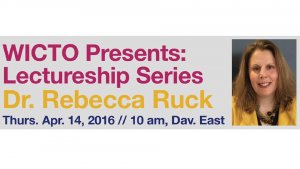
Dr. Rebecca Ruck
Date: Thursday, April 14, 2016
Location: Lash Miller Chemical Laboratories, Davenport East Seminar Room (3rd floor)
Abstract: There is tremendous interest paid to increasing diversity and inclusion across STEM subjects. This emphasis has resulted in diverse career opportunities for talented female chemists across the pharmaceutical industry. This presentation will focus on my personal career progression within the Merck Process Chemistry organization. It will include scientific highlights from my time in the lab and from team members under my supervision. It will highlight the accomplishments of women and demonstrate my passion to recruit and retain women in chemistry. This has been achieved by building relationships with female graduate students and providing mentorship and sponsorship for these women as they enter the organization and grow into roles of increasing responsibilities.
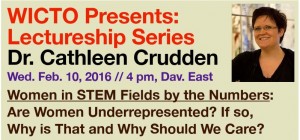
Dr. Cathleen Crudden
Date: Wednesday, Feb. 10, 2016
Location: Lash Miller Chemical Laboratories, Davenport East Seminar Room (3rd floor)
Biography: Cathleen Crudden graduated from the University of Toronto with Mark Lautens, and obtained her Ph.D. with Howard Alper at the University of Ottawa. After an NSERC-PDF with Scott Denmark, she became Assistant Professor at the University of New Brunswick, where she held the first University Research Professorship (2001). In 2002, she moved to Queen’s University as Queen’s National Scholar. In 2012, she was cross-appointed as Research Professor at ITbM in Japan as one of four international PIs and runs a satellite lab there.
Crudden’s research centers on catalysis and materials. She described the first enantiospecific Suzuki-Miyaura cross-coupling reaction of chiral boranes in a very highly recognized paper. In 2014, she reported N-heterocyclic carbene-based self-assembled monolayers in work called “game changing” by experts in the field. Her work is highly cited with one paper being among the top 10 cited papers in Canada in all areas of science.
She has won numerous awards including a Premier’s Research Excellence Award, a Chancellor’s Research Award, the 2010 Catalysis Lectureship award, a 2010 NSERC Accelerator Award and the Clara Benson award. In 2015, she led a successful $8.8M CFI Innovation Fund application.

Dr. Stephanie MacQuarrie
Date: Tuesday, January 19th, 2016
Location: Lash Miller Rm 158 (University of Toronto, St. George Campus)
Title: How Homogeneous Are These Heterogeneous Organic Catalysts?
Abstract: The development of an efficient, convenient and recyclable catalytic system based on a supported organocatalyst is still a major challenge. The search for a green catalyst, and our interest in the synthesis of porous silica based materials prompted us to explore an alternative immobilization method, in which a chiral imidazolium salt derived from trans-L-hydroxyproline, is immobilized on the surface of mesoporous silica so that the imidazolium cation is covalently linked to the silica, but the proline anion is bound via electrostatic interactions. We suspect this allows the proline more freedom to react in the solution state, making it more available to participate in catalysis resulting in higher activity then past heterogeneous proline catalysts have shown. We report excellent isolated yields in the aldol condensation reaction (up to 99%), as well as modest selectivities (ee up to 85%). The stability and sustained activity of the catalyst were investigated and the results show that no loss of catalyst activity was found, even after five recoveries (washing & drying) and recycles. The NHC-based material demonstrated intriguing carbon dioxide capture ability.
2015
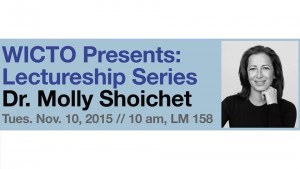
Dr. Molly Shoichet
Title: My Top 10 List of Things to do to be Successful in your Career
Abstract: Women pursuing research careers in academia or industry are faced with a series of challenges and balancing acts. Having a partner who values your career as much as you do is key to success, as is having a support system. Life can be a struggle, but with more people on your team, life can be more of an adventure. I will describe my life’s adventure in science in the context of my top 10 list of things to do to be successful (at least in North America) and highlight some of our recent findings in research.
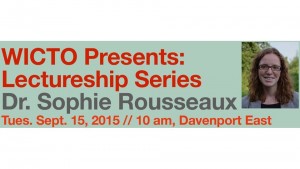
Dr. Sophie Rousseaux
Title: Supramolecular Chemistry of Porphyrin Nanorings
Abstract: Fully pi-conjugated macrocycles have attracted significant attention due to their interesting optical and electronic properties. The Anderson group at the University of Oxford has recently prepared conjugated porphyrin nanorings using strategies that rely on molecular recognition and cooperative self-assembly. Notably, these macrocycles resemble the chlorophyll arrays in the light-harvesting antennae of natural photosynthetic systems.
